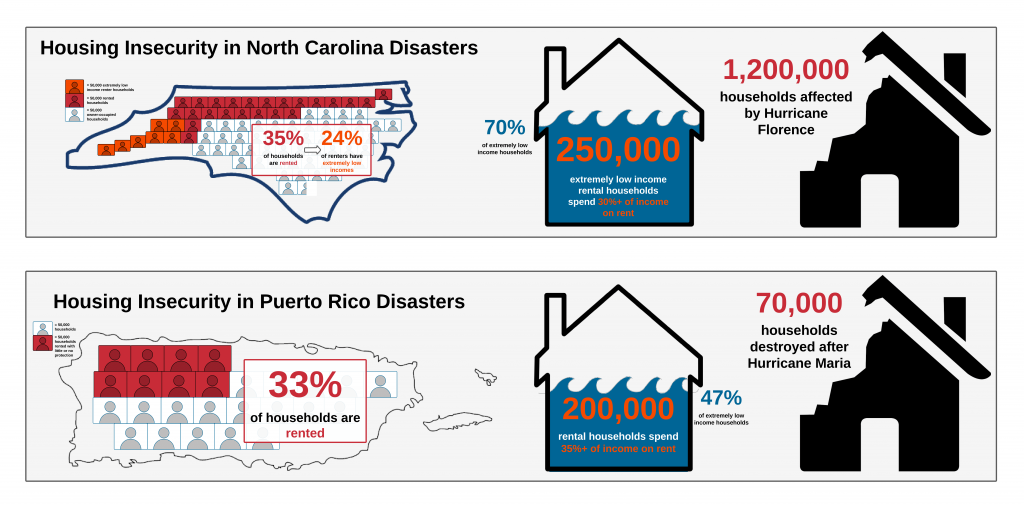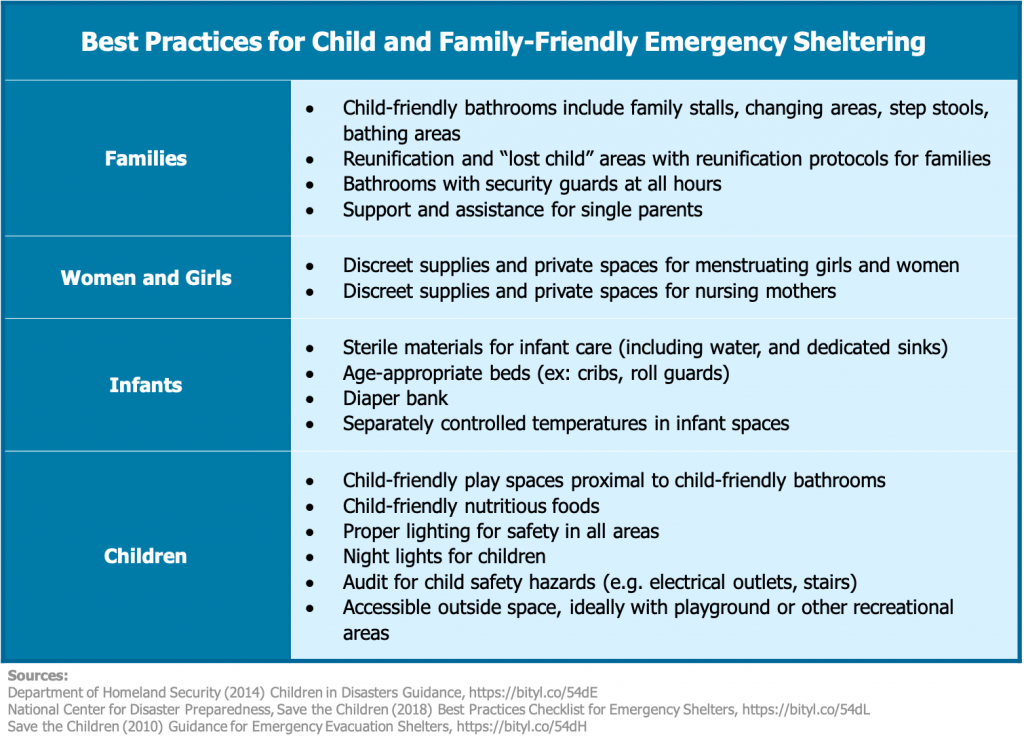Introduction | Childcare in Disasters | Broadband in Education | Mental Health and Well-Being | Emergency Shelters and Housing Security | Food Security and Poverty | Summary
Emergency Shelters and Housing Security: Executive Summary
Maintaining stable housing for vulnerable communities, including children, should be a top priority in addition to ensuring that emergency shelters are properly prepared to meet the needs of children in disaster situations. Children require stability and routine to minimize the effects of trauma from disasters. A critical factor in achieving this is for all children to have a stable and disaster-resilient home. For those who are unable to stay in their home after a disaster, emergency shelter planning should explicitly plan to accommodate the unique needs of children. At the same time, shelter plans should consider locations that reduce reliance upon using schools as shelters in order to ensure educational continuity for children after disasters.
What Are Communities Saying?
Scroll to the left or right to see what communities across America are saying about emergency shelters and housing security.
Spotlight On: Puerto Rico
Emergency Shelters
Four months after Hurricane Maria, and well into the winter season, blue tarps still covered 60,000 roofless houses in Puerto Rico of the 70,000 originally damaged.[i] Eight out of ten households with one or more children were affected by the storm, and the disaster impacts on children extended beyond housing into education due to half of all operational shelters being located in schools, impeding the start of the school year.[ii]
Many Puerto Ricans chose to shelter-in-place for Hurricane Maria in 2017. Concerns about shelters and their effects on children and families are common as many prefer to stay at home for the stability and safety it provides. Women and children are particularly vulnerable in a shelter environment, with valid concerns about gender-based violence.[iii] Since domestic violence support programs are often not considered essential services, they are not obligated to liaise with emergency management or have a presence at shelters.
Housing Stability
Housing instability is sometimes conflated with homelessness, but it encompasses a broader subset of society, including low to moderate income households struggling to pay rent or mortgages on time; people living in unsafe housing conditions; high likelihoods of evictions; overcrowded housing markets with low supply; unstable neighborhoods (like disaster-prone areas); and homelessness. This creates additional stressors on parents, caregivers, and children.
The discrepancies between resources available to property owners versus renters result in questions about equitable and fair recovery. In portions of America where renting is prevalent, many government programs targeted to homeowners are perceived as exclusionary. In Puerto Rico, one-third of the population are renters and are also “rent burdened” where greater than 35% of monthly income is spent on rent.[iv]
Increasing Flexibility for Rebuilding While Maintaining Safety
Ensuring housing stability for children in disasters requires programs that promote the building of stable structures with sound roofs while providing better protections for renters. Puerto Ricans are asking for community-led housing programs that mitigate flood and landslide risk so that restrictions on rebuilding in hazard-prone areas can be lifted. Locals also strongly support promoting the inclusion of renters and non-title bearers in housing programs and guarantees for effective community participation.
Meeting the Disaster Housing Needs of America’s Children
The psychological impacts of disaster displacement on children are severe. After Hurricane Katrina, children who were displaced from their homes experienced 4.5 times the instances of serious emotional disturbances compared to non-displaced children. Unfortunately, 50% of parents who sought mental health aid were unable to access professional services.[v] Thus, one of the most powerful ways to minimize childhood disaster trauma and the long-term effects on community health is to increase the possibility of maintaining stable housing throughout a disaster scenario. An analysis suggests that 75% of child poverty and housing insecurity could be reduced or eliminated by combining the proposed expansion to the Section 8 housing choice voucher program with S. 4 LIFT the Middle Class Act and S.690 The American Family Act of 2019. [vi][vii]
Emergency sheltering in disasters is intended to provide temporary safe housing and centralized support services until permanent arrangements are found. Yet, emergency shelters are usually located in schools or community centers, which makes it a priority to clear out the shelters quickly. This contradiction makes it difficult for emergency shelters to offer adequate long-term support to families whose homes have been damaged or destroyed while also providing educational continuity and the subsequent economic resilience that the whole community requires to recover from disasters.
The Centers for Disease Control and Prevention’s (CDC) guidance for disaster shelters during the COVID-19 pandemic urges local emergency management offices to prioritize alternatives to emergency shelters to avoid large numbers of people in shared enclosed spaces. Motels, hotels dormitories, and locations for small shelters meeting safety recommendations should be prioritized as locations to house people who cannot remain at home.[viii] Regardless of where shelters are located, child advocates and emergency managers support regulations that explicitly call for child and family-specific provisions to minimize the psychological effects of displacement on children.
There are several legislative efforts for promoting housing security in disasters, including recently proposed legislation H.R. 6724 Public Health Emergency Shelter Act of 2020 and H.R. 6806 COVID-19 Emergency Housing Relief Act of 2020. Both aim to increase emergency solutions for the worsening housing crisis, especially focusing on low- and moderate-income households. Additionally, partial rental assistance through 3-month vouchers was approved as part of the CBDG-CV funds, specifically $45.2 million targeted for rental assistance in Puerto Rico.[ix] Expansion of these and similar programs can continue to mitigate the potential traumas incurred by children in uncertain housing situations. For homeowners, the Federal Housing Administration (FHA) issued and then extended several moratoriums on evictions for mortgage defaults during the pandemic, extending through the year and then reinvigorated with an additional $25 billion for emergency rental assistance in December 2020; however, this solution’s longevity remains uncertain, and renters still lack the full spectrum of relief services provided to homeowners.[x] [xi]
Many community members, including but not limited to Puerto Ricans, would like to see restrictions relaxed on CDBG, CDBG-DR, and similar development programs so that communities can make informed choices for prioritizing local disaster mitigation strategies. There is a strong call for community-informed approaches to long-term housing stability which are currently not being met by federal policies and programs.
Recommendations
- All emergency shelters should include child-friendly accommodations as part of the sheltering plan.
- Create more options using non-school shelters to promote educational continuity in disasters.
- Support community-led secure housing initiatives in disaster-prone areas, especially for renters in low and moderate-income communities, to reduce overall disaster sheltering demand and increase efforts to maintain a home-based routine and normalcy for children.
____
[i] Huber, C., & World Vision. (2018, August 1). 2017 Hurricane Maria: Facts, FAQs, and how to help. Retrieved from https://www.worldvision.org/disaster-relief-news-stories/2017-hurricane-maria-facts.
[ii] Instituto del Desarrollo de la Juventud. (2018, December). Impact of Hurricane Maria on Puerto Rico’s Children. Retrieved from https://parsefiles.back4app.com/NnOrAmAotAZqACgSOms8WkAwkOIqpZ6VWjoFVKeJ/e7cb314c136dca44c72d8570b9afb3f4_20511.pdf.
[iii] Schlegelmilch, J., Rivera, A., Samur, A., Sury, J., Delgado, Y., Stewart, A., & White, Z. (2020). Children of Puerto Rico and COVID-19 Webinar Proceedings. In Children of Puerto Rico and COVID-19 – At the Crossroads of Poverty and Disaster. New York, NY: National Center for Disaster Preparedness. Retrieved from https://rcrctoolbox.org/wp-content/uploads/2020/07/COVID-19-PR-Webinar-Proceedings_EN_07302020.pdf.
[iv] Schlegelmilch, J., Rivera, A., Samur, A., Sury, J., Delgado, Y., Stewart, A., & White, Z. (2020). Children of Puerto Rico and COVID-19 Webinar Proceedings. In Children of Puerto Rico and COVID-19 – At the Crossroads of Poverty and Disaster. New York, NY: National Center for Disaster Preparedness. Retrieved from https://rcrctoolbox.org/wp-content/uploads/2020/07/COVID-19-PR-Webinar-Proceedings_EN_07302020.pdf.
[v] Redlener, I. E., De Rosa, C. & Parisi, K. (2010). Legacy of Katrina: The impact of a flawed recovery on vulnerable children of the Gulf Coast. Paper presented at IOM Workshop on Human Health Effects of Gulf Oil Spill from the National Center for Disaster Preparedness and Columbia University Mailman School of Public Health. https://doi.org/10.7916/D8H420TK.
[vi] Biden for President. (2020). The Biden Plan for Investing in Our Communities Through Housing. Retrieved from https://joebiden.com/housing.
[vii] Center on Policy and Social Poverty. (2020, October 7). Pairing housing vouchers with expansions to tax credits could cut the national poverty rate in half. Columbia University. Retrieved from https://www.povertycenter.columbia.edu/news-internal/2020-policy-proposal-housing-vouchers.
[viii] Centers for Disease Control and Prevention. (2020, October 31). Interim Guidance for Homeless Service Providers. Retrieved from https://www.cdc.gov/coronavirus/2019-ncov/community/homeless-shelters/plan-prepare-respond.html.
[ix] US Department of Housing and Urban Development. (2020). CDBG-CV: CDBG CARES Act. Retrieved from https://www.hudexchange.info/programs/cdbg-cv/.
[x] HUD Public Affairs. (2020). FHA Extends Foreclosure and Eviction Moratorium for Homeowners Through Year End. Retrieved from https://www.hud.gov/press/press_releases_media_advisories/HUD_No_20_134.
[xi] House Committee on Appropriations. (2021, January). H.R.133 Division-by-Division Summary of COVID-19 Relief Provisions. United States House of Representatives. Retrieved from https://www.congress.gov/bill/116th-congress/house-bill/133.
Last updated: April 9, 2021


